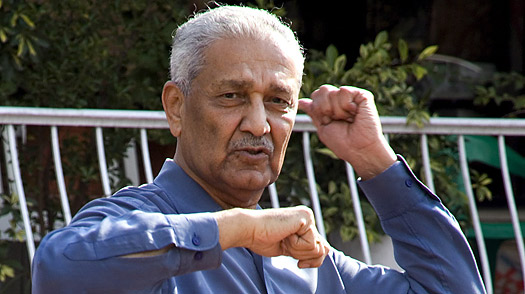Abdul Qadeer Khan, also known as A.Q. Khan (born April 1, 1936, Bhopal, India), Pakistani engineer, a key figure in Pakistan’s nuclear weapons program who was also involved for decades in a black market of nuclear technology and know-how whereby uranium-enrichment centrifuges, nuclear warhead designs, missiles, and expertise were sold or traded to Iran, North Korea, Libya, and possibly other countries.
In 1947, during Khan’s childhood, India achieved independence from Britain, and Muslim areas in the east and west were partitioned to form the state of Pakistan. Khan immigrated to West Pakistan in 1952, and in 1960 he graduated from the University of Karachi with a degree in metallurgy. Over the next decade he pursued graduate studies abroad, first in West Berlin and then in Delft, Netherlands, where in 1967 he received a master’s degree in metallurgy. In 1972 he earned a doctorate in metallurgical engineering from the Catholic University of Leuven in Belgium. Meanwhile, in 1964 he married Hendrina Reterink, a British national who had been born to Dutch expatriate parents in South Africa and raised in what was then Northern Rhodesia (now Zambia) before moving to the Netherlands.
In the spring of 1972 Khan was hired by Physical Dynamics Research Laboratory, a subcontractor of the Dutch partner of URENCO. URENCO, a consortium of British, German, and Dutch companies, was established in 1971 to research and develop uranium enrichment through the use of ultracentrifuges, which are centrifuges that operate at extremely high speeds. Khan was granted a low-level security clearance, but, through lax oversight, he gained access to a full range of information on ultracentrifuge technology and visited the Dutch plant at Almelo many times. One of his jobs was to translate German documents on advanced centrifuges into Dutch.
Khan was heavily influenced by events back home, notably Pakistan’s humiliating defeat in a brief war with India in 1971, the subsequent loss of East Pakistan through the creation of a new independent country, Bangladesh, and India’s test of a nuclear explosive device in May 1974. On September 17, 1974, Khan wrote to Pakistan’s prime minister, Zulfikar Ali Bhutto, offering his assistance in preparing an atomic bomb. In the letter he offered the opinion that the uranium route to the bomb, using centrifuges for enrichment, was better than the plutonium path (already under way in Pakistan), which relied on nuclear reactors and reprocessing.
Bhutto met Khan in December 1974 and encouraged him to do everything he could to help Pakistan attain the bomb. Over the next year Khan stole drawings of centrifuges and assembled a list of mainly European suppliers where parts could be procured. On December 15, 1975, he left the Netherlands for Pakistan, accompanied by his wife and two daughters and carrying his blueprint copies and suppliers list.
Khan initially worked with the Pakistan Atomic Energy Commission (PAEC), but differences arose with its head, Munir Ahmad Khan. In mid-1976, at Bhutto’s direction, Khan founded the Engineering Research Laboratory, or ERL, for the purpose of developing a uranium-enrichment capability. (In May 1981 the laboratory was renamed the Khan Research Laboratory, or KRL.) Khan’s base of operations was in Kahuta, 50 km (30 miles) southeast of Islamabad; there Khan developed prototype centrifuges based on German designs and used his suppliers list to import essential components from Swiss, Dutch, British, and German companies, among others.
In the early 1980s Pakistan acquired from China the blueprints of a nuclear weapon that used a uranium implosion design that the Chinese had successfully tested in 1966. It is generally believed that the Chinese tested a derivative design for the Pakistanis on May 26, 1990.
On 11th may 1998 India tested his three nukes and on 13th may tested another two nukes to show the strategic strength in the region. As a result the Prime Minister Mian Nawaz Sharif took decision to test the Pakistani nukes for the balancing of Power in the region.
Pakistan successfully tested its Primary Atomic weapon on 28, May 1998 in Chaghi Hills located in Blouchistan. Pakistani Scientists selected the Koh-e-Kamran for the Test. According to Pakistani Standard time Dr Abdul Qadeer Khan pushed the Fire Trigger on 3:17 pm. Within few minutes of Explosion the whole rock of Koh-e-Kamran turn into yellowish ice dust and Pakistan became a Nuclear Power.

No comments:
Post a Comment